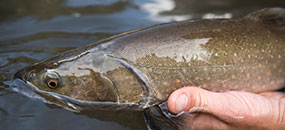Salmon Treaty Agreement Major Step Forward, Says Trout Unlimited
Contact:
9/29/1999 -- -- Trout Unlimited and Trout Unlimited Canada today commended the U.S. and Canadian negotiators for the Pacific salmon agreement announced June 3 in Vancouver, British Columbia and Seattle, Washington. The agreement ended a long stalemate over implementation of the Pacific Salmon Treaty.
"Overall, we are very pleased with the agreement," said Charles Gauvin, President of Trout Unlimited. "It addresses our main concern, the conservation of the all of the diverse stock s of Pacific Salmon, through an innovative approach that will share the burden of conservation between mixed - stock fisheries in the ocean and the near shore and freshwater fisheries closer to the spawning grounds of individual stocks. It also creates a major new source of funding for habitat protection and restoration and research."
"I am very happy to see that the agreement focuses on conservation driven management," said Tim Hamilton, Chairman of the Board of Trout Unlimited Canada. "Hopefully, this will be the first step towards better cooperation between the parties to the treaty."
At the heart of the agreement are three major new elements:
- A New Agreement on Chinook Salmon: The parties agreed to an abundance based management approach of chinook salmon based on total mortality. Previously, the management of ocean fishing of chinook was based on fixed ceilings in Alaska, Northern British Columbia and the West Coast of Vancouver Island. Fisheries closer to the natal rivers of the salmon were managed to pass through the savings to the spawning grounds. In addition, the ceilings were based on landed catch and did not count fish that died after encounters with nets or hooks or fish that were caught incidentally in fisheries targeted on other species. For example, fish that were caught by commercial trollers and released because of size limitations were not counted even though it is estimated that over 20% of those fish do not survive. Under this arrangement, and in part because of it, there has been a coastwide decline in chinook stocks, with many of the chinook stocks originating in Washington, Oregon and Idaho being listed as threatened under the federal Endangered Species Act.
The new agreement will base the ocean harvest of salmon on yearly projections of abundance. In years of normal abundance, ocean fisheries will be set at levels that are about 40% below the previous ceilings. The harvest levels will rise and fall with abundance. Near-shore and in-river fisheries will be managed to protect identified depressed chinook stocks with cuts in harvest rates ranging from 35-40% from previous harvest levels. Where those harvest levels are insufficient to allow a sufficient number of fish to reach their spawning areas, additional reductions are specified.
While this arrangement is not all that TU had asked for, it is a major step in the right direction and addresses two major concerns with the current treaty - the reliance on fixed ceilings and the failure to account for so-called incidental mortality.
- Fraser River Sockeye and Washington Coho: The parties resolved the issues surrounding the interceptions of Fraser River sockeye by U.S. fishers. Sockeye runs returning to the Fraser River in Canada number in the millions of fish. They are intercepted in the Strait of Juan de Fuca and Puget Sound by U.S. Native American and non-Indian commercial fishers. Those interceptions have long been a source of conflict between the two countries, particularly as Canada, unlike the U.S. on the Columbia River, has forgone hydropower development on the Fraser River to protect salmon. The new agreement calls for a substantial reduction in the U.S. catch, from approximately 26% during the first years of the treaty to slightly more than 16%, which will be implemented by a buy-out of non-Indian fishing licenses.
In exchange for the reductions in U.S. interceptions of Fraser sockeye, Canada has agreed to a conservation based regime for border area fisheries in southern British Columbia and Washington State. Coho stocks from Washington are subject to heavy fishing pressure in southern B.C. and the West Coast of Vancouver Island. The new regime will be developed over the next year and put in place in the 2000.
- Funding for Habitat Protection and Restoration: The agreement creates two new funds which would be managed bilaterally to address science, restoration and enhancement needs. The Northern Boundary and Transboundary Rivers Fund would provide funding for projects in Northern B.C. and Alaska. The Southern Fund would address needs in southern British Columbia, the states of Washington and Oregon and the Snake River Basin in Idaho. The U.S. would contribute $140 million over the next four years to establish the funds.
In January 1999, at the height of the dispute between the U.S. and Canada, Trout Unlimited joined with Trout Unlimited Canada to issue a report recommending specific measures for resolving the stalemate. Many of the report's recommendations, including the call for abundance based management based on total mortality and the buy out of Puget Sound sockeye salmon licenses, are reflected in the recent agreement.
"This is a critical step for the recovery of a number of badly damaged stocks of Washington and Oregon chinook and coho, and an important step for the few remaining endangered Snake River chinook which have been subject to the Alaskan and Canadian interception fisheries," said Gauvin. "Those fish, especially the Snake River-origin fish, need all the help they can get. However, this is only the beginning. In the end, we will not judge this agreement by the handshakes of the negotiators but by the health of our shared salmon runs."
Trout Unlimited and Trout Unlimited Canada are North America's leading coldwater conservation organizations, dedicated to the conservation, protection and restoration of North America's trout and salmon fisheries and their watersheds. Together, the two organizations represent over 110,000 members in 472 Chapters in North America and are the largest trout and salmon conservation organization in the world.
Date: 9/29/1999



